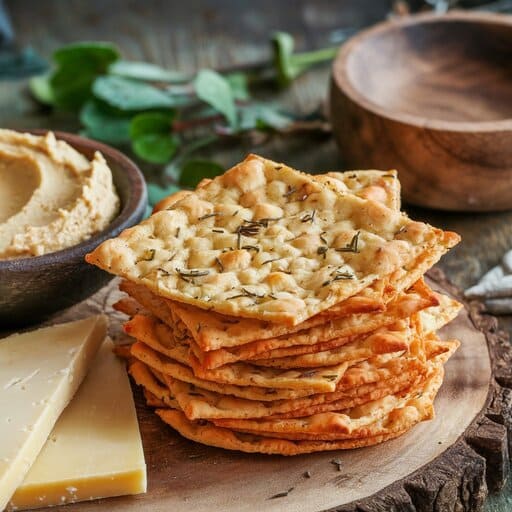Introduction
In the world of sourdough baking, there’s one common dilemma every enthusiast faces what to do with the excess sourdough starter, or “discard,” that accumulates during the feeding process. Instead of tossing it away, why not turn this byproduct into something utterly delicious? Enter Sourdough Discard Crackers, a simple yet ingenious way to repurpose your sourdough discard into crispy, flavorful crackers that can be enjoyed as a snack, paired with cheese, or dipped into your favorite spreads.
These crackers are not just a solution to reduce waste but also a delightful treat that adds a homemade touch to any snack platter. Perfectly crisp, with a tangy undertone from the sourdough, they are an excellent way to use every bit of your sourdough starter.
Bread is the king of the table and all else is merely the court that surrounds the king.
Louis Bromfield
Plus, they’re incredibly easy to make and customizable with a variety of flavors and toppings. This recipe is a testament to the idea that in the kitchen, waste can be a stepping stone to something wonderful.

Table of Contents
Why You’ll Love This Sourdough Discard Crackers Recipe
Reduces Food Waste: This recipe is the perfect way to use up sourdough discard, minimizing food waste while creating something tasty.
Quick and Easy: With minimal ingredients and simple steps, these crackers are a breeze to make, even on a busy day.
Customizable: From herbs to seeds, you can easily customize the flavor of these crackers to suit your palate.
Healthy Snack Option: Made with wholesome ingredients and baked to perfection, these crackers are a healthier alternative to store-bought snacks.
Versatile Pairing: These crackers pair well with a variety of dips, cheeses, and spreads, making them a versatile addition to any snack or appetizer platter.
How to Make Sourdough Discard Crackers
Ingredients
- 1 cup sourdough discard (unfed)
- 1 cup all-purpose flour
- 1/4 cup olive oil (plus extra for brushing)
- 1/2 tsp sea salt (plus extra for sprinkling)
- Optional flavor additions: herbs (rosemary, thyme), seeds (sesame, flax), spices (garlic powder, onion powder), or cheese (grated Parmesan)
Instructions
Ingredients:
Prepare the Dough: In a large bowl, combine the sourdough discard, flour, olive oil, and salt. Mix until the ingredients come together to form a smooth dough. If the dough is too sticky, add a bit more flour; if it’s too dry, add a little more sourdough discard or water.
Flavor the Dough: If you’re adding any optional flavorings (like herbs, seeds, or cheese), now is the time to mix them into the dough. Knead briefly to evenly distribute the flavors.
Rest the Dough: Cover the dough with plastic wrap and let it rest for 30 minutes at room temperature. This will make it easier to roll out.
Preheat the Oven: Preheat your oven to 350°F (175°C). Line two baking sheets with parchment paper.
Roll Out the Dough: Divide the dough into two equal portions. On a lightly floured surface, roll out each portion as thinly as possible (around 1/8 inch or 3mm thick). The thinner the dough, the crispier the crackers will be.
Cut and Arrange: Use a sharp knife or pizza cutter to cut the dough into desired shapes squares, rectangles, or even triangles. Transfer the cut dough onto the prepared baking sheets. Brush the tops with a bit of olive oil and sprinkle with extra sea salt or your chosen toppings.
Bake the Crackers: Bake in the preheated oven for 20-25 minutes, or until the edges are golden brown and the crackers are crisp. Keep an eye on them in the last few minutes to avoid burning.
Cool and Store: Remove from the oven and let the crackers cool on a wire rack. Once completely cooled, store them in an airtight container for up to a week.

Tips for the Sourdough Discard Crackers
Rolling the Dough: For the crispiest crackers, roll the dough as thin as possible. If your dough is too thick, the crackers will be more like flatbread.
Even Baking: To ensure even baking, try to roll the dough to a uniform thickness and rotate the baking sheet halfway through cooking.
Flavor Variations: Experiment with different herbs, spices, and seeds to find your favorite flavor combination. For a cheesy twist, mix grated Parmesan into the dough or sprinkle it on top before baking.
Storage: Keep the crackers in an airtight container to maintain their crispness. If they soften, you can re-crisp them in the oven at 300°F (150°C) for a few minutes.
Perfect Pairing: These crackers are perfect on their own or served with dips like hummus, guacamole, or even a classic cheese board.
Waste not, want not.
Benjamin Franklin
Sourdough Discard Crackers Recipe FAQ
Do you have to discard every time you feed sourdough?
No, you don’t always have to discard sourdough every time you feed it, but it is a common practice. Discarding helps maintain the right ratio of starter to fresh flour and water, ensuring your starter stays healthy and active. If you don’t discard:
- The starter will grow too large and require more flour and water to maintain.
- It can become overly acidic, affecting its performance.
You can avoid waste by using the discard in recipes like pancakes, waffles, crackers, or biscuits. Alternatively, you can refrigerate the starter to reduce the frequency of feedings and discard less often.
How long can sourdough discard stay on the counter?
Sourdough discard can typically stay on the counter for a few hours (up to 6–8 hours) if the temperature is mild (around 68–72°F or 20–22°C). However:
- At warmer temperatures, it ferments faster and can turn overly acidic or spoil more quickly.
- For longer storage, place the discard in the refrigerator, where it can last for up to 1–2 weeks.
Always smell and inspect the discard before use to ensure it hasn’t spoiled.
How to know if sourdough discard has gone bad?
You can tell if sourdough discard has gone bad by looking for these signs:
- Foul Odor: A strong, unpleasant smell, like mold or rot, indicates spoilage.
- Mold: Visible mold in the form of green, black, or fuzzy spots means the discard is unsafe to use.
- Pink or Orange Tint: A pink, orange, or discolored hue suggests bacterial contamination.
- Excessive Liquid: While some liquid (hooch) on top is normal, a large amount with an off-putting smell may signal that the discard is past its prime.
If in doubt, it’s better to discard and start fresh.
Can you use a day 1 sourdough discard?
Yes, you can use day 1 sourdough discard in recipes, but its leavening power will be minimal. A new starter doesn’t have enough wild yeast and bacteria built up to contribute to rising dough effectively. However:
- Day 1 discard is still rich in flavor and acidity, making it suitable for recipes that don’t rely on rising, such as pancakes, flatbreads, or crackers.
- For recipes requiring leavening, use discard from a mature starter.
Can you feed starters without discarding?
Yes, you can feed a starter without discarding, but this is usually not recommended unless you’re using or scaling up the starter immediately. If you skip discarding:
- The starter will grow in size, requiring significantly more flour and water to maintain.
- It may become too acidic, which can harm the yeast and bacteria balance, reducing its effectiveness.
Discarding ensures your starter remains manageable, balanced, and healthy over time.
Does sourdough discard need to be room temperature before using?
Not necessarily. You can use sourdough discard straight from the refrigerator in most recipes. However:
- Room Temperature Discard: This can make it easier to mix into doughs or batters and may slightly enhance the flavor.
- Cold Discard: Works just as well for many recipes, especially if it will be combined with warm ingredients or baked.
If the recipe relies on the yeast in the discard for leavening, letting it come to room temperature may help activate the yeast more effectively.

Sourdough Discard Crackers
Equipment
- Mixing bowl
- Rolling Pin
- Sharp knife or pizza cutter
- Baking sheets
- Parchment paper
- Cooling rack
Ingredients
- 1 cup sourdough discard unfed
- 1 cup all-purpose flour
- 1/4 cup olive oil plus extra for brushing
- 1/2 tsp sea salt plus extra for sprinkling
- Optional flavor additions: herbs rosemary, thyme, seeds (sesame, flax), spices (garlic powder, onion powder), or cheese (grated Parmesan)
Instructions
- Prepare the Dough: In a large bowl, combine the sourdough discard, flour, olive oil, and salt. Mix until the ingredients come together to form a smooth dough. If the dough is too sticky, add a bit more flour; if it’s too dry, add a little more sourdough discard or water.
- Flavor the Dough: If you’re adding any optional flavorings (like herbs, seeds, or cheese), now is the time to mix them into the dough. Knead briefly to evenly distribute the flavors.
- Rest the Dough: Cover the dough with plastic wrap and let it rest for 30 minutes at room temperature. This will make it easier to roll out.
- Preheat the Oven: Preheat your oven to 350°F (175°C). Line two baking sheets with parchment paper.
- Roll Out the Dough: Divide the dough into two equal portions. On a lightly floured surface, roll out each portion as thinly as possible (around 1/8 inch or 3mm thick). The thinner the dough, the crispier the crackers will be.
- Cut and Arrange: Use a sharp knife or pizza cutter to cut the dough into desired shapes—squares, rectangles, or even triangles. Transfer the cut dough onto the prepared baking sheets. Brush the tops with a bit of olive oil and sprinkle with extra sea salt or your chosen toppings.
- Bake the Crackers: Bake in the preheated oven for 20-25 minutes, or until the edges are golden brown and the crackers are crisp. Keep an eye on them in the last few minutes to avoid burning.
- Cool and Store: Remove from the oven and let the crackers cool on a wire rack. Once completely cooled, store them in an airtight container for up to a week.
Notes
Nutrition (Per Serving):
Calories: 150 | Carbohydrates: 18g | Protein: 3g | Fat: 7g | Saturated Fat: 1g | Polyunsaturated Fat: 1g | Monounsaturated Fat: 5g | Sodium: 150mg | Potassium: 40mg | Fiber: 1g | Sugar: 0g | Vitamin C: 0mg | Calcium: 10mg | Iron: 1mgCommon Mistakes When Making Sourdough Discard Crackers
- Not Rolling the Dough Thin Enough
- A thick dough results in soft crackers instead of crispy ones. Ensure the dough is rolled out to about 1/8 inch or less for the best texture.
- Uneven Dough Thickness
- Inconsistent rolling leads to uneven baking. Some crackers may burn while others remain undercooked. Use a rolling pin to achieve a uniform thickness.
- Skipping Rest Time
- Skipping the 30-minute rest makes the dough harder to roll and can impact the final texture. Allowing the dough to rest ensures easier handling and better results.
- Overbaking or Underbaking
- Baking times can vary based on dough thickness. Overbaking leads to burnt edges, while underbaking leaves the crackers chewy. Keep a close eye during the last few minutes.
- Not Using Parchment Paper
- Placing the dough directly on a baking sheet can cause sticking. Use parchment paper to ensure easy removal and even cooking.
- Neglecting Flavor Additions
- Forgetting to season or add toppings like herbs, seeds, or cheese can leave the crackers bland. Enhance flavor by sprinkling toppings before baking.
- Improper Storage
- If crackers are not stored in an airtight container, they lose their crispness. Proper storage keeps them fresh and crunchy for up to a week.
Conclusion
Sourdough discard crackers are a perfect example of how to transform kitchen waste into a delicious, versatile snack. By avoiding common mistakes like uneven rolling or overbaking, you can achieve perfectly crisp and flavorful crackers every time. This recipe is not only a creative way to minimize waste but also an opportunity to experiment with different flavors and toppings. Whether paired with dips, spreads, or enjoyed on their own, these crackers showcase the beauty of sourdough baking in every bite.
Let me know!
Did you find this post helpful? By leaving a star rating and share, it will help others find my recipes.




